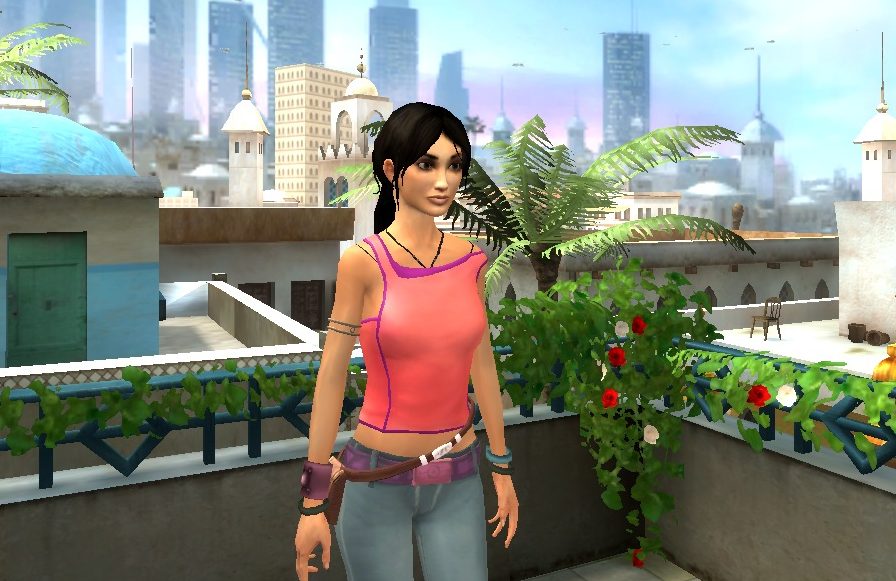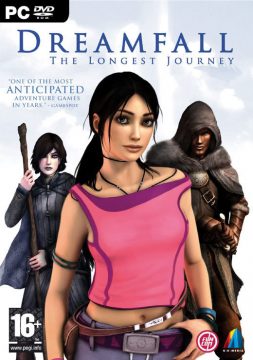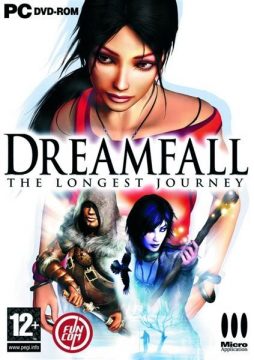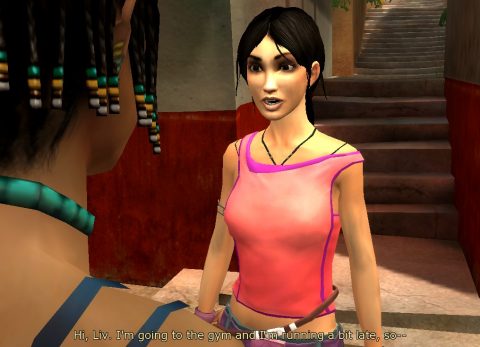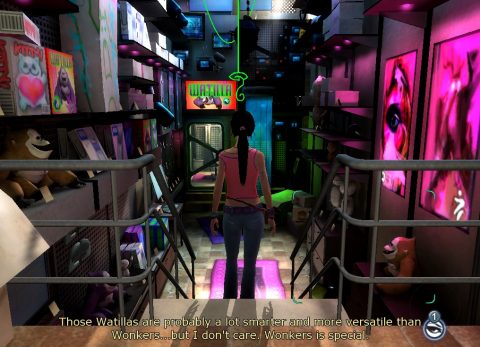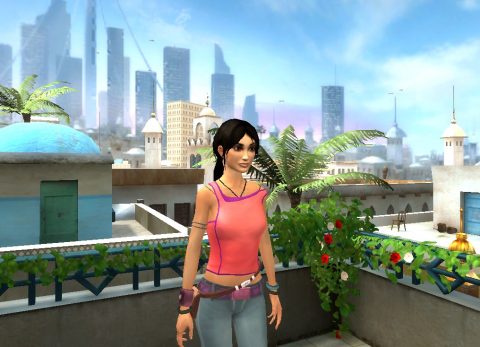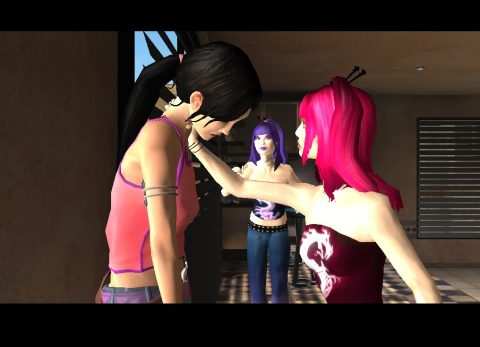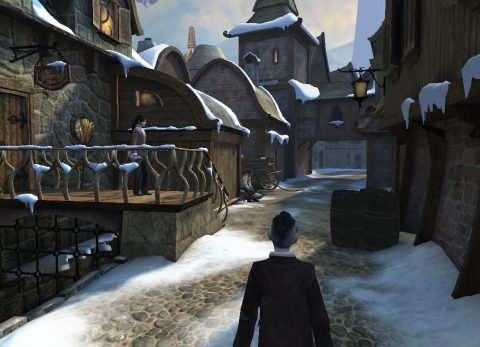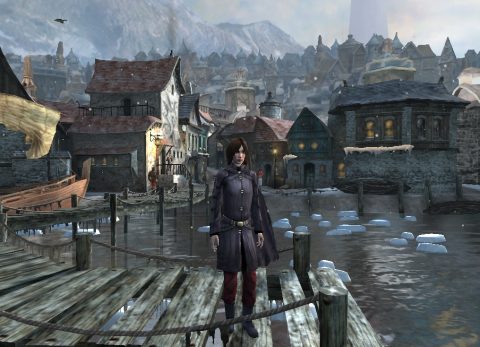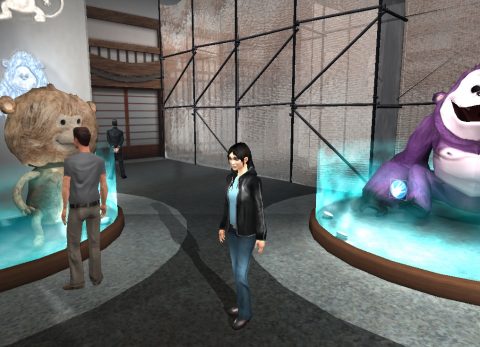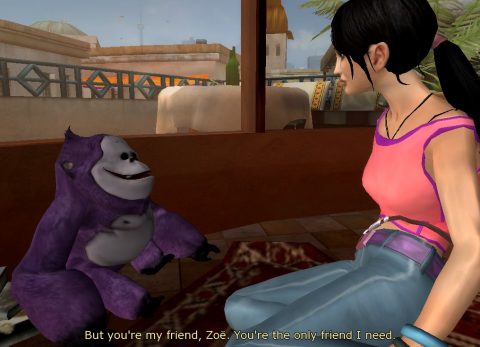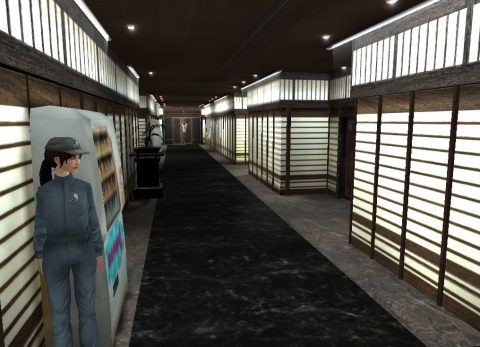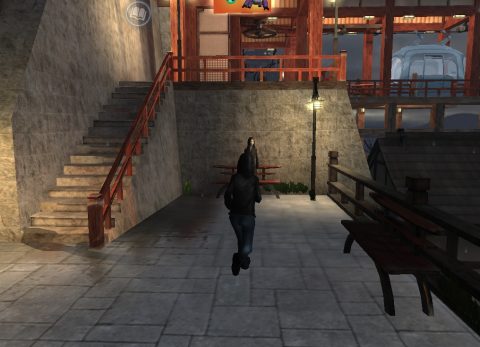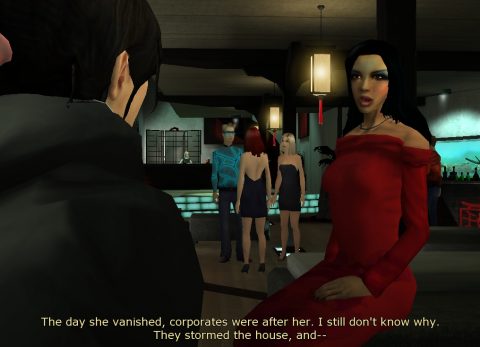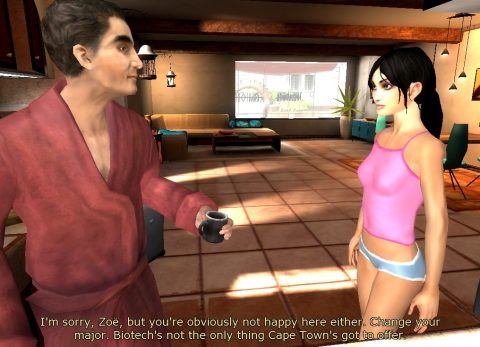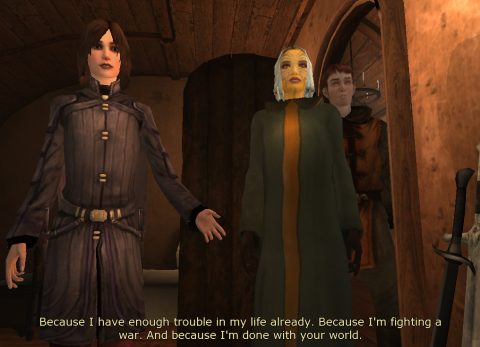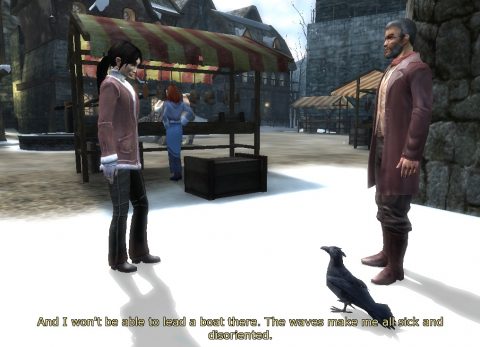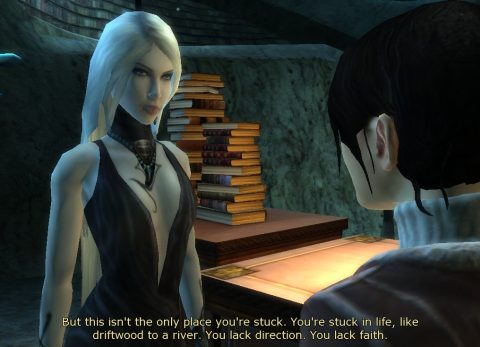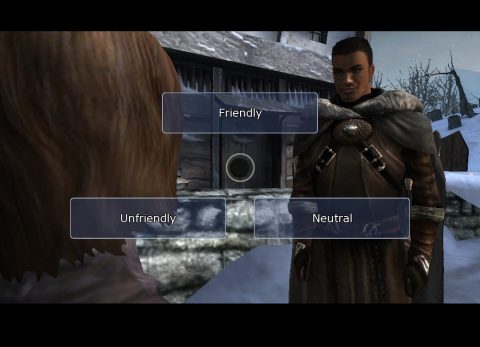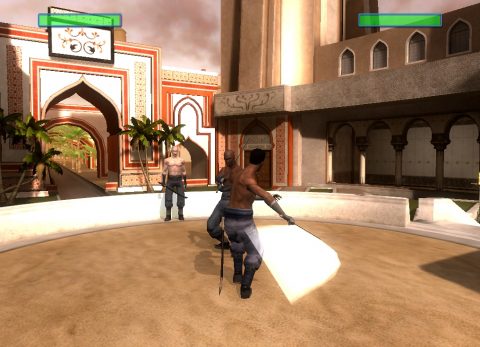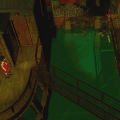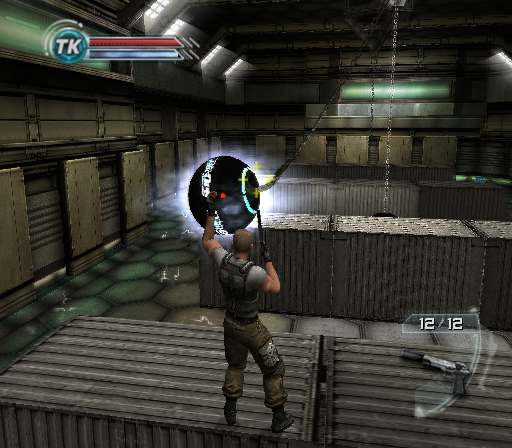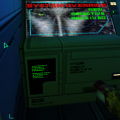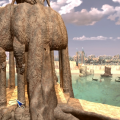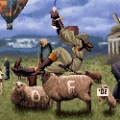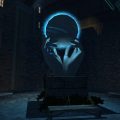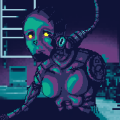- Longest Journey, The
- Dreamfall: The Longest Journey
The Longest Journey had a fairly satisfying conclusion, but given the depth of the world it was clear that Tørnquist had plenty more stories to tell. In 2006, seven years after its release, Funcom released Dreamfall: The Longest Journey, for both the PC and Xbox.
Dreamfall begins 10 years after the end of its predecessor and initially focuses on a young woman named Zoë Castillo. For reasons she’s can’t quite explain, she’s found herself losing a sense of purpose, breaking up with her boyfriend Reza and dropping out of college, spending her days aimlessly lounging around her father’s house in the city of Casablanca. Things start getting freaky when she has persistent visions of a young girl whispering at her to: “Find and save April Ryan.” If that weren’t creepy enough, Reza has gone missing during an investigation of WATI, a huge corporation working on several technological breakthroughs. Her quest sends her back to Venice in Newport to discover WATICorp’s yet-to-be revealed product – “Dreamtime”, an entertainment product that allows people to experience fully lucid dreams, completely under their control. Zoë, however, learns she is a “Dreamer”, and using this product will mysteriously transport her to Arcadia without needing to Shift.
Meanwhile, Arcadia isn’t exactly in the best shape. The city of Marcuria is under occupation by an outside force called the Azadi, imposing their religion on its reluctant people and criminalizing magic. April is the secret leader of the rebel movement, and she’s changed quite a bit from the last game. For reasons she can’t fully comprehend, she can no longer Shift between worlds, and even her participation in the rebellion is more out of self-destruction than loyalty to her people. She’s confused to find Zoë, who’s been transported to Arcadia without Shifting, and Zoë is equally as surprised to find the same April Ryan mentioned by the mysterious little girl. As it turns out, April believes that there’s nothing she needs to be “saved” from and wants little to do with her.
Across the lands of Arcadia, a third character is introduced – Kian, an apostle who questions his empire’s motivations. Compared to Zoë and April, Kian isn’t nearly as fleshed out, nor does he have much of a personality. There are only few segments where you play as him, and he seems to exist mostly to provide shades of grey in the battle between Marcuria and Azadi. Eventually the stories of the three converge into one. Zoë deepens further into the conspiracy and learns more of the links between the worlds, April begins a quest of personal discovery, and Kian learns the error of his people’s ways.
Technically Dreamfall‘s plot stands alone, but there are a lot of characters from the first game, and their presence doesn’t make much sense unless you’ve played it. One of the coolest things in Dreamfall is seeing how locations and characters have changed in the 10 years between the two games. Venice, once a burgeoning, beautiful college town, is now nothing more than a rainy depressing trash heap. Charlie and Emma, the friends that we spent a considerable amount of time with during the opening hours of The Longest Journey, only to be more or less abandoned as the story progressed, are still baffled and depressed over the mysterious loss of April. Crow, too, makes a comeback as the wisecracking sidekick and, more or less, comes off as a bit less annoying. Other returning characters include fellow Shifter Brian Westhouse and former nemesis Roper Klacks (now a reformed potion salesman), who both play minor but welcome roles. And then there’s April herself, no longer bubbly, and having long grown embittered with her life in Arcadia and the fallout from the ending of the first game. Her arc doesn’t have remotely the same impact if you haven’t played the original, and so she may just come off as overtly stand-offish.
Like so many other adventure games, Dreamfall sheds the point-and-click interface and 2D graphics, and replaces it with direct control in a fully 3D environment. For other series, this hasn’t always worked well, but Dreamfall remarkably pulls it off. A lot of this has to do with the atmosphere – although there’s nothing amazing about the graphics from a technical standpoint, both worlds are gorgeously designed, with each of the cities possessing their own unique architecture and color palette. If nothing else, it shows how far some good art direction can make up for a lack of technical prowess. And even rendered in real-time it’s certainly better than any of the cinemas from The Longest Journey.
As much as long time fans may hate to admit it, there’s a certain special feeling that comes in actually walking through the snow covered streets of Marcuria, instead of just clicking over a static picture of it. In many ways, the sense that you’re exploring an actual living breathing world evokes the moods of Shenmue, even if the game world isn’t nearly as interactive as Sega’s classic. The characters, too, feel much more alive, and the dialogue scenes are much more involving due to the close-ups and camera angle changes. The animation isn’t perfect, but considering again that this also isn’t a high budget project, it’s more than suitable. It doesn’t hurt that the dialogue itself is more straightforward, and while there’s still lots of talking, it never feels extraneous.
Furthermore, Funcom has pulled off a remarkable job in both the designs and the modeling of these characters. The Japanese have long scoffed at Western character designs, especially when it comes to women, who are often derided as putrid and ugly. When Lara Croft, with her ridiculous proportions and unnatural face of her initial game, is the only recognizable sex symbol of your industry, then that’s something of an issue. Zoë, along with April, and even some of the secondary characters, are actually quite attractive, demolishing that stereotype quite nicely.
While it’s nice to look at, Dreamfall falters when it comes to the actual gameplay. Funcom acknowledged that a lot of people gave up on The Longest Journey due to its difficult puzzles. Instead of making them easier, their solution was simply to remove them almost completely. There are naturally obstacles to overcome, but most of them can be solved by using Zoë’s mobile phone to hack them, or simply by talking to various people. There are at least a few segments that amount to little more than fetch quests, and what few puzzles do exist are extremely easy, because you never have more than a couple of items in your inventory at any time. There are two types of hacking minigames, which are not only rare but also easily conquerable.
As some kind of replacement for puzzles, Funcom integrated some action elements, notably a few fighting and stealth sequences. Adventure gamers have groaned about these since the genre’s inception, and Dreamfall does little to quell their concerns. The fighting segments, although brief and easy, are atrocious, with stiff movement and almost non-existent collision detection. The stealth segments are, thankfully, much less painful and equally as brief. Unlike its predecessor, you can technically be killed in Dreamfall, but since the game autosaves right before any dangerous situation, you don’t need to worry about getting caught off guard.
It’s clear that Dreamfall is much more about “story” than “game”. If you can rationalize it like that, then Dreamfalleasily shines as one of the best written storylines in video gaming. Dreamfall was released simultaneously on the PC and Xbox platforms. It did well on the PC but didn’t meet sales expectations on the Xbox, possibly because it just didn’t jell with the system’s audience. Still, it’s a decent port. The PC version runs at a higher resolution, with a smoother frame-rate and faster load times, but the Xbox version is still more than respectable, and runs quite well on the Xbox 360 too, where it was re-released as part of the Xbox Originals line on Xbox Live. Playing with a joypad is an absolute necessity regardless, because the mouse controls in the PC version are a pain.
At its initial release, Europe got a special limited edition of Dreamfall which includes the game, a hardbound artbook, a four-track CD with the vocal songs used in the game by the band Magnet, and a few postcards. Beware that this edition includes the dreaded Starforce copy protection. A later collector’s edition was released in the United Kingdom, featuring both Dreamfall and The Longest Journey, the soundtrack score CD, and the artbook. The Game of the Year edition released in North America is mostly the same package but omits the artbook.
Comparing and Contrasting the Storylines
(Some light spoilers follow. Please read with caution)
Despite being so closely related, there are some pretty substantial differences in the storylines of both games. The Longest Journey is a classic hero’s journey, spanning several lands and cultures through the magical world of Arcadia, and even a few dingy spots in the “real” world of Stark. It’s full of funny and outright weird characters, and Dreamfall doesn’t quite have that. There’s not nearly as much dialogue in the sequel either, and the trees are much simpler, where you pick topics instead of direct lines. There are a few interesting characters, particularly April’s Watilla, a friendly robotic gorilla toy which doubles as a personal organizer and talks with an oddly quiet demeanor similar to Teddy from Steven Spielberg’s A.I. (he’s even voiced by the same voice actor). There are a couple of other oddball characters throughout, but none of them stand out in the same way that Roper Klacks did in the first game. Most of the best characters are the ones that make recurring appearances. And while Zoë, a determined heroine with a gorgeous British accent, is a fine heroine, she lacks April’s witticisms and her humor is much drier.
From a storytelling standpoint, Dreamfall is also far, far different, focusing primarily on Zoë’s search for the truth, April’s fight against the rebels, Kian’s fight against his people, and all three protagonists’ search for purpose and a renewal of faith. There’s far less of an emphasis on Arcadia as a whole – outside of a few brief locations, the setting rarely leaves the city of Marcuria and only mentions the other races and history in passing. This isn’t necessarily a bad change, because there’s a mystery driving the player forward, and it’s more than just tracking down MacGuffins.
Still, the world of Arcadia is so vast and densely layered that, for as much time as you spent listening about it in The Longest Journey, it still felt like there was more to explore. Certain important events happened off screen, like the invasion of Marcuria by an outside force, because it didn’t directly involve April. Dreamfall expands on the existing mythology, which in turn strengthens the world, and even deals with the fallout from said invasion.
At the same time, though, Dreamfall‘s story rapidly becomes unfocused. With three main characters and multiple threads in their stories, it tosses at lot at you. Sure, all characters are put through journeys of faith, so they have that in common, but from a plot standpoint it’s never entirely clear how it all fits together. And this is further elucidated by the ending, possibly one of the worst cliffhangers in all of video gaming.
It’s the “worst” not because it’s technically bad or anything. It’s not because it was rushed through production like the finale of Star Wars: Knights of the Old Republic II, nor is it a victim of crappy writing. It’s intentionally set up that way, since Tørnquist always envisioned Dreamfall as the second part of a trilogy. If you go into it realizing this, you’ll probably be less aggravated, but it still ends up unsatisfying.
Lots of people compare it to the ending of The Empire Strikes Back, but it’s not really fitting, because Dreamfall‘s is much, much more depressing. Furthermore, out of the half-dozen or so story threads, only one of them is really resolved, and the rest are left hanging. And then, during the ending, the writers twist the knife even further by introducing more questions for which there are (yet) no explanation. And at least everyone knew that Return of the Jedi would be coming. Tørnquist has been promising a sequel since Dreamfall came out, but given the reality of game development, it’s not a certainty. It could very well go the way of Shenmue, which ended at the second game. But even though Shenmue stopped partway through its overall arc, at least the game told some kind of standalone story, whereas Dreamfall mostly feels like a huge setup.
If nothing else, it helps identify video gaming as a unique medium of storytelling, separate from books or film. At the beginning of Dreamfall, Zoë is in a coma, narrating the story in the form of a flashback. As the player, we’re given hope that we can somehow save her from her rather grave condition, but no – by the end of the game, she’s still bed-ridden with little hope of ever waking up. Even though there are no alternate paths or endings, it still somehow feels like we, the player, have failed her in some way, making the finale all the more heart-breaking.
Still, even if you end up aggravated by the ending, at least it shows how much you care about the worlds of Arcadia and Stark, its story, and its characters. Both games work together brilliantly, and it only makes one hungry for The Dreamfall Chapters, which was crowdfunded and wasn’t released until 2014, eight years after Dreamfall.
Links:
Rocks Paper Shotgun Several articles and interviews regarding both of the games.
TLK Wiki An expansive wiki detailing both games.
The Longest Journey Official site for the first game.
Dreamfall Official site for the second game.
Ragnar Tørnquist’s personal blog
